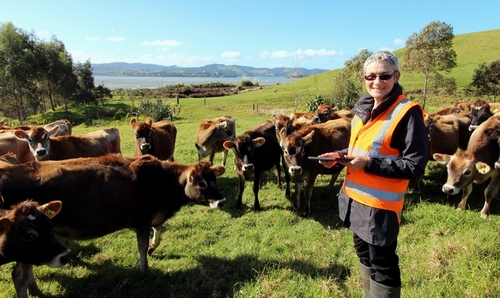Summer survey to help improve future harbour water quality
16 Aug 2016, 11:03 AM
Stock is currently excluded from about 40 percent of waterways ‘in pasture’ in the Whangarei Harbour catchment, a regional council survey has found.
Two tertiary students hired by the council for the summer had walked all the streams ‘in pasture’ (farmland and lifestyle blocks) between December last year and February, covering more than 250 kilometres on foot during the process.
 Land Management Advisor Lorna Douglas visits a well-fenced Portland farm, one of many Whangarei Harbour properties visited over summer as part of a regional council catchment survey.
Land Management Advisor Lorna Douglas visits a well-fenced Portland farm, one of many Whangarei Harbour properties visited over summer as part of a regional council catchment survey.
Lorna Douglas, a council Land Management Advisor, says the students were looking at stock exclusion fencing, fish passage barriers, stream bank erosion, general riparian vegetation and weeds. (Urban streams or those in bush or pine forestry weren’t surveyed as stock weren’t likely to be present there.)
A wealth of accurate information had been recorded in the field on iPads that could be used by multiple teams across the council, including planning, land management, biodiversity and State of the Environment monitoring staff.
“The survey covered more than 400km of stream banks, with one of the key findings being that about 40% of these currently had stock effectively excluded.”
Information collected included;
- the presence and condition of fencing
- the nature and features of any barriers to native fish movement
- stream bank erosion
- the type of vegetation alongside streams.
Ms Douglas says the council was grateful to landowners for their interest in, and support of, the project. Results had helped support an application – currently being processed – for about $270,000 of Ministry for the Environment funding over the next three years to extend riparian fencing and planting in the Hatea catchment.
Data from the survey had also already been used by the Whangarei Harbour Catchment Group to write its draft catchment plan, part of a current plan review process by the council.
The council recently released its the Draft Regional Plan, an important new plan that will eventually set out how the region’s water, air, land and the coast are managed.
Key proposed changes in the draft plan include new limits on taking water from rivers, lakes and aquifers and new stock exclusion rules for rivers, drains, wetlands and lakes.
At the same time as it’s seeking feedback on that draft, the council is also focussing on the Whangarei Harbour as one of six priority catchments across the region.
It’s tailoring the way fresh water is managed in the Doubtless Bay, Pouto, Waitangi, Whangarei and Mangere catchments to address issues of particular concern to those communities.
Over the past several years catchment groups have been formed from community, industry and tangata whenua representatives with an interest in those catchments.
“They’ve developed draft catchment management plans that address fresh water related issues and contain rules that apply in addition to/instead of those in the Draft Regional Plan. They also contain a variety of non-regulatory approaches, including more research and actions to improve the state of fresh water.”
Feedback on the Draft Regional Plan and catchment plans can be made until 5pm on Friday 23 September, including online.
More information about the Draft Regional Plan is available online via: www.nrc.govt.nz/newregionalplan and the catchment management plans via www.nrc.govt.nz/waiorafeedback
Meanwhile, Ms Douglas says people interested in funding help to fence waterways should contact a Land Management Advisor on 0800 002 004.
